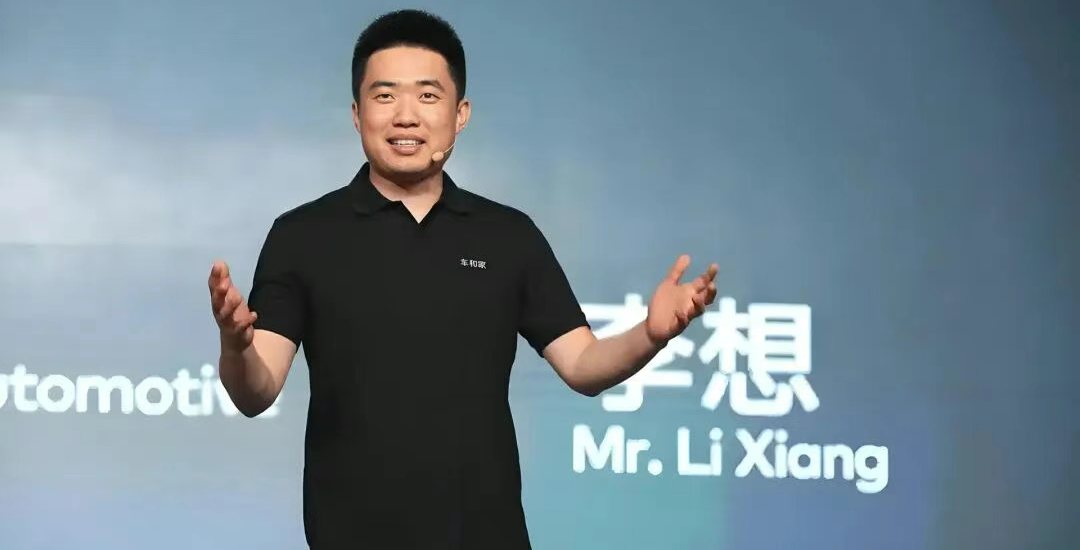Ideal's Defensive Barrier: Easily Breached
![]() 11/27 2025
11/27 2025
![]() 503
503

Li Xiang: 'Forced' Back onto the Entrepreneurial Journey
Li Auto has unveiled a financial report that falls short of 'ideal' expectations.
On November 26, Li Auto released its third-quarter financial performance report. The data reveals that the company's total revenue for the third quarter of 2025 stood at RMB 27.4 billion, marking a year-on-year decline of 36.2% from RMB 42.9 billion in the third quarter of 2024, and a quarter-on-quarter decrease of 9.5% from RMB 30.2 billion in the second quarter of this year.
In terms of net profit, Li Auto transitioned from profitability to a loss this quarter, recording a net loss of RMB 624 million. In stark contrast, the net profits for the third quarter of 2024 and the second quarter of 2025 were RMB 2.8 billion and RMB 1.1 billion, respectively.
Regarding the gross profit margin, the company's overall gross profit margin for the third quarter plummeted to 16.3%, a decrease of 5.2 percentage points from 21.5% in the same period last year. The vehicle gross profit margin took a significant hit, dropping to 15.5%, well below the 20.9% recorded in the same period last year.
In terms of vehicle deliveries, Li Auto delivered a total of 93,211 vehicles in the third quarter, representing a year-on-year decrease of 39%.
Judging solely from the financial report data, Li Auto's third quarter can be regarded as the darkest period in recent memory. So, what exactly transpired at Li Auto?
01
Li Auto: Encircled by Competitors from All Directions
Looking back from 2025, Li Auto is no longer the same entity it was six years ago.
To be frank, Li Auto's financial performance in the third quarter was indeed lackluster, but the severity of its poor performance has been somewhat overstated by external factors.
For instance, the vehicle profit margin in the third quarter stood at 15.5%, showing a significant decline both year-on-year from 20.9% and quarter-on-quarter from 19.4% in the previous quarter. However, this decline was partly influenced by factors such as the recall of the Mega.
At the end of October, Li Auto announced a recall of 11,411 MEGA 2024 electric vehicles due to inadequate anti-corrosion performance of the coolant. Under specific conditions, this could lead to corrosion and leakage of the cooling aluminum plate in the power battery and front motor controller cooling circuits, resulting in vehicle fault lights illuminating, limited power, and failure to power on, directly impacting the gross profit margin.
However, after excluding this factor, Li Auto's management indicated during the conference call that the gross profit margin for the third quarter would have reached 20.4%.
Regarding the decline in delivery volume, the market had already anticipated it to some extent. Current sales of new energy vehicles are nearly transparent, with monthly and even weekly sales figures being meticulously analyzed. Therefore, the market had already taken precautions against the decline in delivery volume.
Nevertheless, the problems lurking behind the decline in delivery volume and the guidance indicating that delivery volume will continue to decline are undeniable facts. Over the past two years, Li Auto had constructed a seemingly impregnable defensive barrier in the 300,000-500,000 RMB SUV market by accurately targeting family users, refining the extended-range experience, and adopting a relatively conservative pricing strategy.
However, since the second half of last year, this defensive barrier has been quietly eroded from three directions: Below, models like the Leapmotor C16 have entered the six-seater SUV market at less than half the price of Li Auto's models. Although their configurations are basic, they precisely cater to budget-conscious family users. Above, the Seres M9 has firmly established itself as the 'king of cars' with its intelligent driving and luxury labels, while the M7 facelift has locked down Li Auto's L8 core customer base at a lower threshold. Even the M8 is seen as a natural replacement for the L9.
In the middle ground, the XPeng G9 and G6 prices continue to decline, and NIO has launched a counterattack supported by its battery swap network. Even the Xiaomi YU7 has diverted many young family users who would have otherwise chosen the L6, leveraging its ecological synergy and Lei Jun's influential presence.
Li Auto clearly did not anticipate this rapid and precise encirclement.
It is evident that Li Auto assumed that the refreshed L6/L7/L8/L9 models could continue their dominance from last year with minor upgrades and slight price adjustments, but it overlooked two critical points.
First, consumer patience for 'superficial iterations' is rapidly dwindling. Second, competitors are no longer content with merely 'benchmarking parameters' but are directly reconstructing value anchors—either through stronger intelligent driving experiences (like Seres), extreme cost-effectiveness (like Leapmotor), or charismatic leadership (like Xiaomi).
As a result, the decline in Li Auto's extended-range models has exceeded the expectations of the company's management. Even with the accelerated launch of the pure electric i6, it is impossible to fill such a substantial gap.
This trend is also reflected in the company's guidance for the fourth quarter.
For the fourth quarter of 2025, Li Auto expects delivery volume to be between 100,000 and 110,000 units, with total revenue projected between RMB 36.5 billion and RMB 39.2 billion during the conference call, significantly lower than the market expectation of 138,000 units. This is even with the continued acceleration of the i6, indicating that the L-Series is facing severe 'internal and external' challenges.
The decline in sales will also trigger a series of chain reactions: To boost sales, discounts on the L-Series terminal are bound to increase, while the i6's market entry with a 'lower fuel cost than electric' pricing strategy will result in an actual gross profit margin lower than that of the L-Series. The combination of these two factors means that Li Auto's long-standing vehicle gross profit margin of around 20% may be at risk in the fourth quarter.
This is just the predicament for 2025. Although Li Auto still has ample cash reserves and no immediate survival concerns, the market environment has undergone a dramatic transformation.
Compared to the past two years, today's competitive landscape is more intricate: XPeng is backed by Volkswagen, and Leapmotor has partnered with Stellantis, not only gaining technological synergy but also opening up export channels. Players in the Seres, Smart, HI, and HI Plus models are intensively launching models, continuously raising user expectations for intelligent driving experiences. Xiaomi is accelerating the completion of its product lineup, and NIO is regaining momentum with its battery swap and sub-brand strategies.
This also implies that Li Auto will continue to face pressure next year. At that time, even with another major facelift, it will not be able to revert to its past glory.
02
Digging Canals and Fortifying Walls: Li Auto Gears Up for a Tough Battle
So, what strategies does Li Auto have in response to such a severe situation?
During the conference call, an analyst from Bank of America inquired about the major facelift of the L-Series in 2026, and Ma Donghui provided a somewhat insightful response:
“For the 2026 L-Series facelift, in terms of model configuration, we will revert to a streamlined SKU model while considering market coverage and supply efficiency. We aim to achieve a comprehensive upgrade of core experiences and completely eliminate the pain point of discounted experiences in entry-level versions.”
“In terms of design, we will continue the classic design genes of the L-Series while enhancing the luxury feel. We will strike a balance between the brand's high recognizability and the freshness of user experience to create product forms that better meet family needs.”
“In terms of technology, all models will come standard with 5C ultra-fast charging technology, which will better synergize with our current pure electric ultra-fast charging network to alleviate range anxiety. At the same time, relying on our first-mover advantage and technological accumulation in the extended-range field, we will further strengthen the brand perception of Li Auto as the leader in extended-range vehicles.”
However, this response seems to be somewhat vague and lacks concrete details. The specific upgrades will only be fully revealed when the new L-Series is launched.
In addition to the L-Series facelift, Li Xiang has maintained a 'low-key' and silent demeanor during these times, but he has also been actively working on some technological innovations.
According to Li Xiang, the controller equipped with the self-developed AI inference chip M100 is currently in the large-scale system testing phase and is expected to commence commercialization next year. After formal delivery, users will genuinely experience a fundamental transformation in product value and experience. Specifically, the car will transition from a 'passively used tool' to a service provider with automation and proactive capabilities.
Furthermore, personnel changes at Li Auto are also underway.
According to reports, on November 11, Li Auto issued an internal organizational adjustment announcement, formally marking the end of its three-year journey of 'learning from Huawei.'
The integration of the Organization Department and the Human Resources Department, along with the successive resignations of Huawei-system core executives Li Wenzhi and Yuan Chunfeng, and Li Xiang personally taking over human resources work, signify that Li Auto has completely abandoned the Huawei management model and returned to a centralized management track led by its founder.
Abandoning the Huawei model is indeed understandable. While it provided sufficient support for the rapid increase in sales during Li Auto's initial rapid development phase, after the market stabilized, the 'forced ranking' of PBC performance triggered vicious competition within the sales team, with frequent issues such as cross-regional order snatching and internal commissions. Meanwhile, the process reforms led by Li Wenzhi doubled the approval chain, completely incompatible with Li Auto's agile style.
Li Xiang's return to managing personnel and his comprehensive return to a startup company model also aim to correct the 'big company' culture and reintegrate Li Auto into a fast-moving and agile team.
In summary, in terms of products, Li Auto is undergoing a fundamental shift from relying on extended-range vehicles to breaking through with pure electric models. Organizationally, it is bidding farewell to the 'learning from Huawei' experiment and returning to an agile model led by its founder. Technologically, it is betting on self-developed AI chips and intelligent agent experiences, attempting to regain the initiative in the next wave.
However, all these adjustments, while not exactly a 'last-ditch effort,' are no longer just icing on the cake in a favorable situation. The defensive barrier that was once built through precise positioning and rhythmic advantages has now been easily breached by competitors from multiple dimensions. The Li Auto of the future must truly carve its own path and tackle tough challenges.
The market will no longer give Li Auto time to 'win with minor upgrades and slight price adjustments.' The real test has just begun.
- END-







